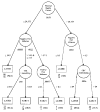Tracing the roots of early sexual debut among adolescents in psychiatric care
- PMID: 12707564
- PMCID: PMC1201420
- DOI: 10.1097/01.CHI.0000046833.09750.91
Tracing the roots of early sexual debut among adolescents in psychiatric care
Abstract
Objective: To identify the most important social and personal characteristics related to early sexual debut among troubled teenagers.
Method: One hundred ninety-eight youths aged 12-19 years were recruited from outpatient mental health clinics and completed self-reports and interviews about their age of sexual debut; family, peer, and partner relationships (e.g., parental hostile control, negative peer influence, need for intimacy); and personal characteristics (e.g., achievement motivation, externalizing problems). Broad-band (externalizing, internalizing) and narrow-band (depression/anxiety, delinquency) psychopathology was assessed with the Youth Self-Report and Child Behavior Checklist.
Results: Optimal Data Analysis was used to generate a classification tree model to identify variables associated with whether or not youths initiated oral, vaginal, and/or anal sexual activity before or after age 14. Three social context variables (parental hostile control, negative and positive peer influence) and one personal characteristic (externalizing problems) correctly classified 87.4% of teenagers as initiating sexual activity at < or =14 or >14 years of age.
Conclusions: Parental behavior and peer influence were the most important variables associated with the timing of sexual debut. Results support a social-personal framework for understanding sexual risk-taking among adolescents in psychiatric care, and the data offer relatively strong evidence that specific factors could be used to identify troubled teens at risk for early sexual debut.
Figures

Similar articles
-
Understanding AIDS-risk behavior among adolescents in psychiatric care: links to psychopathology and peer relationships.J Am Acad Child Adolesc Psychiatry. 2001 Jun;40(6):642-53. doi: 10.1097/00004583-200106000-00008. J Am Acad Child Adolesc Psychiatry. 2001. PMID: 11392341 Free PMC article.
-
First coitus for adolescents: understanding why and when.J Am Board Fam Pract. 1997 Mar-Apr;10(2):96-103. J Am Board Fam Pract. 1997. PMID: 9071689
-
Social environment and problem behavior: perceived school safety, gender, and sexual debut.J Sch Nurs. 2010 Apr;26(2):121-30. doi: 10.1177/1059840509343112. Epub 2009 Aug 24. J Sch Nurs. 2010. PMID: 19704048
-
The transition from pediatric to adult care for youth with epilepsy: Basic biological, sociological, and psychological issues.Epilepsy Behav. 2017 Apr;69:170-176. doi: 10.1016/j.yebeh.2016.11.009. Epub 2017 Jan 13. Epilepsy Behav. 2017. PMID: 28089368 Review.
-
Rethinking peer influence and risk taking: A strengths-based approach to adolescence in a new era.Dev Psychopathol. 2024 Dec;36(5):2244-2255. doi: 10.1017/S0954579424000877. Epub 2024 May 16. Dev Psychopathol. 2024. PMID: 38752571 Free PMC article. Review.
Cited by
-
Interventions and Patterns of Risk in Adolescent HIV/AIDS Prevention.Am J Infect Dis. 2006;2(2):80-89. doi: 10.3844/ajidsp.2006.80.89. Am J Infect Dis. 2006. PMID: 19088859 Free PMC article.
-
Mental Health Utilization Among Diverse Parenting Young Couples.Am J Community Psychol. 2015 Sep;56(1-2):89-100. doi: 10.1007/s10464-015-9738-7. Am J Community Psychol. 2015. PMID: 26163272 Free PMC article.
-
Transactional sex among women in Sub-Saharan Africa: A systematic review and meta-analysis.PLoS One. 2023 Jun 8;18(6):e0286850. doi: 10.1371/journal.pone.0286850. eCollection 2023. PLoS One. 2023. PMID: 37289839 Free PMC article.
-
Do parents and peers matter? A prospective socio-ecological examination of substance use and sexual risk among African American youth.J Adolesc. 2011 Oct;34(5):1035-47. doi: 10.1016/j.adolescence.2010.11.004. Epub 2010 Dec 14. J Adolesc. 2011. PMID: 21159374 Free PMC article.
-
Individual and social determinants of early sexual activity: A study of gender-based differences using the 2018 Canadian Health Behaviour in School-aged Children Study (HBSC).PLoS One. 2020 Sep 3;15(9):e0238515. doi: 10.1371/journal.pone.0238515. eCollection 2020. PLoS One. 2020. PMID: 32881922 Free PMC article.
References
-
- Achenbach T (1991a), Manual for the Child Behavior Checklist/4–18 and 1991 Profile. Burlington: University of Vermont Department of Psychiatry
-
- Achenbach T (1991b), Manual for the Youth Self-Report and 1991 Profile. Burlington: University of Vermont Department of Psychiatry
-
- Ajzen I, Fishbein (1980), Understanding Attitudes and Predicting Social Behavior. Englewood Cliffs, NJ: Prentice-Hall
-
- Ary DV, Duncan TE, Biglan A, Metzler CW, Noell JW, Smolkowski K. Developmental model of adolescent problem behavior. J Abnorm Child Psychol. 1999;27:141–150. - PubMed
-
- Bandura A (1994), Social cognitive theory and exercise of control over HIV infection. In: Preventing AIDS: Theories and Methods of Behavioral Interventions. AIDS Prevention and Mental Health, DiClemente RJ, Petersen JL, eds. New York: Plenum, pp 25–59
Publication types
MeSH terms
Grants and funding
LinkOut - more resources
Full Text Sources
Medical

